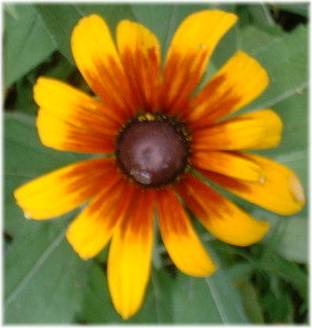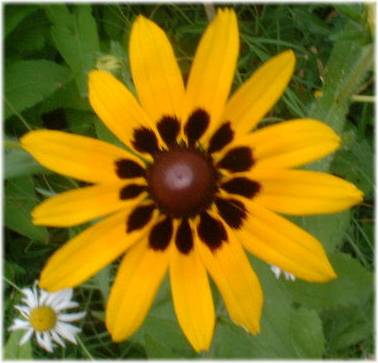|
Gardens Ablaze |
||
|
|
Black-Eyed
Susan
|
|
|
Detailed Wildflower Profiles Site Map
Home
|
Black-Eyed Susans are very easy-care
plants with no special requirements in the garden other than well-drained
soil and full sun or near-full sun. They are included in many perennial
and wildflower mixes, and are a common sight along roadways and in disturbed
areas due to their prolific growth and successful self-seeding. In
the garden, they make a good
Black-Eyed Susans are a very close relative of the venerable herb, Echinacea, and there is some indication that the root has at least the medicinal qualities of Echinacea, and may be an even stronger medicinal plant for the same medical complaints. More study is needed to confirm this, however. See Echinacea in Medicine for more information. Indians used tea made from the roots (and sometimes the leaves) of the plant internally for elimination of worms, for cold symptoms, and topically as a remedy for sores, cuts, and scrapes. The juice squeezed from the roots was used for earaches. The seeds of most Black-Eyed Susans are poisonous, so steer clear of the seed for any herbal uses. The leaves appear to be safe if used in teas internally or topically. Lastly, with their sturdy stems, Black-Eyed Susans make wonderful long-lasting, cheery cut flowers for arrangements. In the garden, they are a strong draw for beneficial insects and wildlife, including bees, butterflies, and hummingbirds, and as such make a wonderful addition to a habitat-type situation. Black-Eyed Susans are also quite drought tolerant, and as such makes a welcome and useful addition to the garden in very hot, dry areas.
Custom Search
|
|
|
Gardens Ablaze |
||
 Black-Eyed
Susan is surely one of the most beloved plants in the wildflower and perennial
garden. It is yet another member of the Aster family, and close family
members include
Black-Eyed
Susan is surely one of the most beloved plants in the wildflower and perennial
garden. It is yet another member of the Aster family, and close family
members include  naturalizing
plant, but beware, some years may be more colorful than others due to their
biennial-type growth habit. They self seed freely, and the roots of
perennial specimens can be divided in the fall for more plants. They
can be started easily by seed in the fall, in flats 6 weeks before the last
frost, or early in the spring for bloom the next year. In the garden,
they are rather nondescript plants before blooming, so other ornamentals
that bloom a little earlier are a good idea to keep the show going.
naturalizing
plant, but beware, some years may be more colorful than others due to their
biennial-type growth habit. They self seed freely, and the roots of
perennial specimens can be divided in the fall for more plants. They
can be started easily by seed in the fall, in flats 6 weeks before the last
frost, or early in the spring for bloom the next year. In the garden,
they are rather nondescript plants before blooming, so other ornamentals
that bloom a little earlier are a good idea to keep the show going.